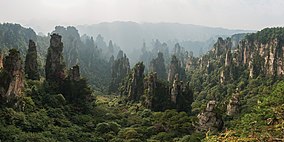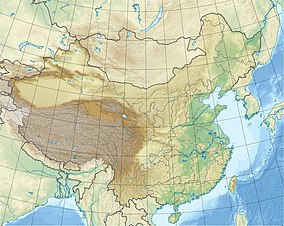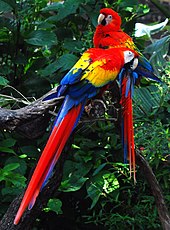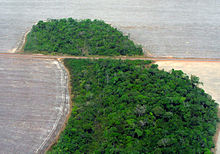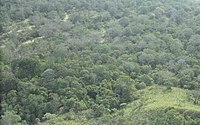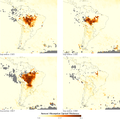| Amazon rainforest |
| Forest |
Amazon rainforest, near Manaus, Brazil. |
| Countries | Brazil, Peru, Colombia, Venezuela,Ecuador, Bolivia, Guyana, Suriname,French Guiana |
|---|
|
| Part of | South America |
|---|
| River | Amazon River |
|---|
|
| Area | 5,500,000 km2 (2,123,562 sq mi) |
|---|
|
Map of the Amazon rainforest ecoregions as delineated by the WWF. Yellow line approximately encloses the Amazon drainage basin. National boundaries shown in black. Satellite image from NASA.
|
The
Amazon rainforest (
Portuguese:
Floresta Amazônica or
Amazônia;
Spanish:
Selva Amazónica,
Amazonía or usually
Amazonia;
French:
Forêt amazonienne;
Dutch:
Amazoneregenwoud), also known in English as
Amazonia or the
Amazon Jungle, is a
moist broadleaf forest that covers most of the
Amazon Basin of South America. This basin encompasses 7,000,000 square kilometres (2,700,000 sq mi), of which 5,500,000 square kilometres (2,100,000 sq mi) are covered by the rainforest. This region includes territory belonging to nine nations. The majority of the forest is contained
within Brazil, with 60% of the rainforest, followed by
Peru with 13%,
Colombia with 10%, and with minor amounts in
Venezuela, Ecuador,
Bolivia, Guyana,
Suriname and
French Guiana. States or departments in four nations contain "
Amazonas" in their names. The Amazon represents over half of the planet's remaining
rainforests, and it comprises the largest and most species-rich tract of
tropical rainforest in the world.
Etymology
The name 'Amazon' is said to arise from a war
Francisco de Orellana fought with a tribe of
Tapuyas and other tribes from South America. The women of the tribe fought alongside the men, as was the custom among the entire tribe.
[1] Orellana derived the name Amazonas from the mythical
Amazons of Asia and Africa described by
Herodotus and
Diodorus in
Greek legends.
[1]
History
Natural
The rainforest likely formed during the
Eocene era. It appeared following a global reduction of tropical temperatures when the Atlantic Ocean had widened sufficiently to provide a warm, moist climate to the Amazon basin. The rain forest has been in existence for at least 55 million years, and most of the region remained free of
savanna-type
biomes at least until the
current ice age, when the climate was drier and savanna more widespread.
[2][3]
Following the
Cretaceous–Paleogene extinction event, the extinction of the
dinosaurs and the wetter climate may have allowed the tropical rainforest to spread out across the continent. From 65–34
Mya, the rainforest extended as far south as
45°. Climate fluctuations during the last 34 million years have allowed savanna regions to expand into the tropics. During the
Oligocene, for example, the rainforest spanned a relatively narrow band that lay mostly above latitude
15°N. It expanded again during the
Middle Miocene, then retracted to a mostly inland formation at the
last glacial maximum.
[4] However, the rainforest still managed to thrive during these glacial periods, allowing for the survival and evolution of a broad diversity of species.
[5]

Aerial view of the Amazon rainforest.
During the
mid-Eocene, it is believed that the drainage basin of the Amazon was split along the middle of the continent by the
Purus Arch. Water on the eastern side flowed toward the Atlantic, while to the west water flowed toward the
Pacific across the
Amazonas Basin. As the
Andes Mountains rose, however, a large basin was created that enclosed a lake; now known as the
Solimões Basin. Within the last 5–10 million years, this accumulating water broke through the Purus Arch, joining the easterly flow toward the Atlantic.
[6][7]
There is evidence that there have been significant changes in Amazon rainforest vegetation over the last 21,000 years through the
Last Glacial Maximum (LGM) and subsequent deglaciation. Analyses of sediment deposits from Amazon basin paleolakes and from the Amazon Fan indicate that rainfall in the basin during the LGM was lower than for the present, and this was almost certainly associated with reduced moist tropical vegetation cover in the basin.
[8] There is debate, however, over how extensive this reduction was. Some scientists argue that the rainforest was reduced to small, isolated
refugia separated by open forest and grassland;
[9] other scientists argue that the rainforest remained largely intact but extended less far to the north, south, and east than is seen today.
[10] This debate has proved difficult to resolve because the practical limitations of working in the rainforest mean that data sampling is biased away from the center of the Amazon basin, and both explanations are reasonably well supported by the available data.
Human activity
Based on
archaeological evidence from an excavation at
Caverna da Pedra Pintada, human inhabitants first settled in the Amazon region at least 11,200 years ago.
[13] Subsequent development led to late-prehistoric settlements along the periphery of the forest by AD 1250, which induced alterations in the forest cover.
[14]

Geoglyphs on deforested land in the Amazon rainforest, Acre.
For a long time, it was thought that the Amazon rainforest was sparsely populated, as it was impossible to sustain a large population through
agriculture given the poor soil. Archeologist
Betty Meggers was a prominent proponent of this idea, as described in her book
Amazonia: Man and Culture in a Counterfeit Paradise. She claimed that a population density of 0.2 inhabitants per square kilometre (0.52 /sq mi) is the maximum that can be sustained in the rain forest through hunting, with agriculture needed to host a larger population.
[15] However, recent
anthropological findings have suggested that the region was actually densely populated. Some 5 million people may have lived in the Amazon region in AD 1500, divided between dense coastal settlements, such as that at
Marajó, and inland dwellers.
[16] By 1900 the population had fallen to 1 million and by the early 1980s it was less than 200,000.
[16]
The first European to travel the length of the
Amazon River was
Francisco de Orellana in 1542.
[17] The BBC's
Unnatural Histories presents evidence that Orellana, rather than exaggerating his claims as previously thought, was correct in his observations that a complex civilization was flourishing along the Amazon in the 1540s. It is believed that the civilization was later devastated by the spread of diseases from Europe, such as
smallpox.
[18]

Left - nutrient-poor soil; right - terra preta
Since the 1970s, numerous
geoglyphs have been discovered on deforested land dating between AD 0–1250, furthering claims about
Pre-Columbiancivilizations.
[19][20] Alceu Ranzi, a Brazilian geographer, is accredited with first discovering the geoglyphs whilst flying over
Acre.
[21] The BBC's
Unnatural Histories presented evidence that the Amazon rainforest, rather than being a pristine
wilderness, has been shaped by man for at least 11,000 years through practices such as
forest gardening and
terra preta.
[18]
Terra preta (black earth), which is distributed over large areas in the Amazon forest, is now widely accepted as a product of indigenous soil management. The development of this fertile soil allowed agriculture and
silviculture in the previously hostile environment; meaning that large portions of the Amazon rainforest are probably the result of centuries of human management, rather than naturally occurring as has previously been supposed.
[22] In the region of the
Xingu tribe, remains of some of these large settlements in the middle of the Amazon forest were found in 2003 by Michael Heckenberger and colleagues of the
University of Florida. Among those were evidence of roads, bridges and large plazas.
[23]
Biodiversity
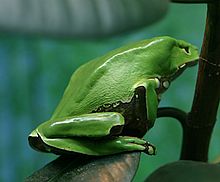
Deforestation in the Amazon Rainforest threatens many species of tree frogs, which are very sensitive to environmental changes (pictured:
Giant leaf frog)
Wet tropical forests are the most species-rich
biome, and tropical forests in the Americas are consistently more species rich than the wet forests in Africa and Asia.
[24] As the largest tract of tropical rainforest in the Americas, the Amazonian rainforests have unparalleled
biodiversity. One in ten known species in the world lives in the Amazon Rainforest.
[25] This constitutes the largest collection of living plants and animal species in the world.
The region is home to about 2.5 million
insect species,
[26]tens of thousands of plants, and some 2,000 birds and
mammals. To date, at least 40,000 plant species, 2,200
fishes,
[27] 1,294 birds, 427 mammals, 428 amphibians, and 378 reptiles have been scientifically classified in the region.
[28] One in five of all the bird species in the world live in the rainforests of the Amazon, and one in five of the fish species live in Amazonian rivers and streams. Scientists have described between 96,660 and 128,843
invertebrate species in Brazil alone.
[29]
The biodiversity of plant species is the highest on Earth with some experts estimating that one square kilometer (247 acres) may contain more than a thousand types of trees and thousands of species of other higher plants. According to a 2001 study, a quarter square kilometer (62 acres) of Ecuadorian rainforest supports more than 1,100 tree species.
[30]
One square kilometer (247 acres) of Amazon rainforest can contain about 90,790 tonnes of living plants. The average plant biomass is estimated at 356 ± 47 tonnes per hectare.
[31] To date, an estimated 438,000 species of plants of economic and social interest have been registered in the region with many more remaining to be discovered or catalogued.
[32]
The green leaf area of plants and trees in the rainforest varies by about 25% as a result of seasonal changes. Leaves expand during the dry season when sunlight is at a maximum, then undergo abscission in the cloudy wet season. These changes provide a balance of carbon between photosynthesis and respiration.
[33]
Deforestation
Deforestation is the conversion of forested areas to non-forested areas. The main sources of deforestation in the Amazon are human settlement and development of the land.
[36] Prior to the early 1960s, access to the forest's interior was highly restricted, and the forest remained basically intact.
[37] Farms established during the 1960s were based on crop cultivation and the
slash and burn method. However, the colonists were unable to manage their fields and the crops because of the loss of
soil fertility and weed invasion.
[38] The soils in the Amazon are productive for just a short period of time, so farmers are constantly moving to new areas and clearing more land.
[38] These farming practices led to deforestation and caused extensive environmental damage.
[39] Deforestation is considerable, and areas cleared of forest are visible to the naked eye from outer space.
In the 1970s construction began on the
Trans-Amazonian highway. This highway represented a major threat to the Amazon rainforest.
[40]Fortunately for the rainforest, the highway has not been completed, hereby reducing the environmental damage.
Between 1991 and 2000, the total area of forest lost in the Amazon rose from 415,000 to 587,000 square kilometres (160,000 to 227,000 sq mi), with most of the lost forest becoming pasture for cattle.
[41] Seventy percent of formerly forested land in the Amazon, and 91% of land deforested since 1970, is used for livestock
pasture.
[42][43] In addition, Brazil is currently the second-largest global producer of
soybeans after the United States. The needs of soy farmers have been used to validate many of the controversial transportation projects that are currently developing in the Amazon. The first two highways successfully opened up the rain forest and led to increased settlement and deforestation. The mean annual deforestation rate from 2000 to 2005 (22,392 km
2 or 8,646 sq mi per year) was 18% higher than in the previous five years (19,018 km
2 or 7,343 sq mi per year).
[44] Deforestation has declined significantly in the Brazilian Amazon since 2004.
[45]
NASA satellite observation of deforestation in the Mato Grosso state of Brazil. The transformation from forest to farm is evident by the paler square shaped areas under development.
Fires and Deforestation in the state of
Rondônia.
One consequence of forest clearing in the Amazon: thick smoke that hangs over the forest.
Conservation and climate change
Environmentalists are concerned about loss of biodiversity that will result from destruction of the forest, and also about the release of the
carbon contained within the vegetation, which could accelerate
global warming. Amazonian evergreen forests account for about 10% of the world's terrestrial primary productivity and 10% of the carbon stores in ecosystems
[46]—of the order of 1.1 × 10
11 metric tonnes of carbon.
[47] Amazonian forests are estimated to have accumulated 0.62 ± 0.37 tons of carbon per hectare per year between 1975 and 1996.
[47]
One
computer model of future
climate change caused by
greenhouse gas emissions shows that the Amazon rainforest could become unsustainable under conditions of severely reduced rainfall and increased temperatures, leading to an almost complete loss of rainforest cover in the basin by 2100.
[48][49] However, simulations of Amazon basin climate change across many different models are not consistent in their estimation of any rainfall response, ranging from weak increases to strong decreases.
[50] The result indicates that the rainforest could be threatened though the 21st century by climate change in addition to deforestation.
In 1989, environmentalist C.M. Peters and two colleagues stated there is economic as well as biological incentive to protecting the rainforest. One hectare in the
Peruvian Amazon has been calculated to have a value of $6820 if intact forest is sustainably harvested for fruits, latex, and timber; $1000 if clear-cut for commercial timber (not sustainably harvested); or $148 if used as cattle pasture.
[51]
As indigenous territories continue to be destroyed by deforestation and
ecocide, such as in the
Peruvian Amazon[52] indigenous peoples' rainforest communities continue to disappear, while others, like the
Urarina continue to struggle to fight for their cultural survival and the fate of their forested territories. Meanwhile, the relationship between non-human primates in the subsistence and symbolism of indigenous lowland South American peoples has gained increased attention, as has ethno-biology and
community-based conservationefforts.
From 2002 to 2006, the conserved land in the Amazon rainforest has almost tripled and deforestation rates have dropped up to 60%. About 1,000,000 square kilometres (250,000,000 acres) have been put onto some sort of conservation, which adds up to a current amount of 1,730,000 square kilometres (430,000,000 acres).
[53]
Anthropogenic emission of greenhouse gases broken down by sector for the year 2000.
Aerosols over the Amazon each September for four burning seasons (2005 through 2008). The
aerosol scale (yellow to dark reddish-brown) indicates the relative amount of particles that absorb sunlight.
Aerial roots of red mangrove on an Amazonian river.
A 2009 study found that a 4 °C rise in global temperatures by 2100 would kill 85% of the Amazon rainforest while a temperature rise of 3 °C would kill some 75% of the Amazon.
[54]
Remote sensing
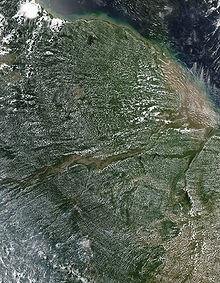
This image reveals how the forest and the
atmosphere interact to create a uniform layer of "popcorn-shaped"
cumulus clouds.
The use of
remotely sensed data is dramatically improving conservationists' knowledge of the Amazon Basin. Given the objectivity and lowered costs of satellite-based land cover analysis, it appears likely that remote sensing technology will be an integral part of assessing the extent and damage of deforestation in the basin.
[55] Furthermore, remote sensing is the best and perhaps only possible way to study the Amazon on a large-scale.
[56]
The use of remote sensing for the conservation of the Amazon is also being used by the indigenous tribes of the basin to protect their tribal lands from commercial interests. Using handheld
GPS devices and programs like
Google Earth, members of the Trio Tribe, who live in the rainforests of southern Suriname, map out their ancestral lands to help strengthen their territorial claims.
[57] Currently, most tribes in the Amazon do not have clearly defined boundaries, making it easier for commercial ventures to target their territories.
To accurately map the Amazon's biomass and subsequent carbon related emissions, the classification of tree growth stages within different parts of the forest is crucial. In 2006 Tatiana Kuplich organized the trees of the Amazon into four categories: (1) mature forest, (2) regenerating forest [less than three years], (3) regenerating forest [between three and five years of regrowth], and (4) regenerating forest [eleven to eighteen years of continued development].
[58] The researcher used a combination of
Synthetic aperture radar (SAR) and
Thematic Mapper (TM) to accurately place the different portions of the Amazon into one of the four classifications.
Impact of early 21st century Amazon droughts
In 2005, parts of the Amazon basin experienced the worst drought in one hundred years,
[59] and there were indications that 2006 could have been a second successive year of drought.
[60] A July 23, 2006 article in the UK newspaper
The Independent reported
Woods Hole Research Center results showing that the forest in its present form could survive only three years of drought.
[61][62] Scientists at the Brazilian
National Institute of Amazonian Research argue in the article that this drought response, coupled with the effects of deforestation on regional climate, are pushing the rainforest towards a "
tipping point" where it would irreversibly start to die. It concludes that the forest is on the brink of being turned into
savanna or
desert, with catastrophic consequences for the world's climate.
According to the
World Wide Fund for Nature, the combination of climate change and deforestation increases the drying effect of dead trees that fuels forest fires.
[63]
In 2010 the Amazon rainforest experienced another severe drought, in some ways more extreme than the 2005 drought. The affected region was approximate 1,160,000 square miles (3,000,000 km
2) of rainforest, compared to 734,000 square miles (1,900,000 km
2) in 2005. The 2010 drought had three epicenters where vegetation died off, whereas in 2005 the drought was focused on the southwestern part. The findings were published in the journal Science. In a typical year the Amazon absorbs 1.5 gigatons of carbon dioxide; during 2005 instead 5 gigatons were released and in 2010 8 gigatons were released.
[64][65]
See also
References
- ^ a b Taylor, Isaac (1898). Names and Their Histories: A Handbook of Historical Geography and Topographical Nomenclature. London: Rivingtons. ISBN 0-559-29668-1. Retrieved October 12, 2008.
- ^ Morley, Robert J. (2000). Origin and Evolution of Tropical Rain Forests. Wiley. ISBN 0-471-98326-8.
- ^ Burnham, Robyn J.; Johnson, Kirk R. (2004). "South American palaeobotany and the origins of neotropical rainforests".Philosophical Transactions of the Royal Society 359 (1450): 1595–1610. doi:10.1098/rstb.2004.1531. PMC 1693437.PMID 15519975.
- ^ Maslin, Mark; Malhi, Yadvinder; Phillips, Oliver; Cowling, Sharon (2005). "New views on an old forest: assessing the longevity, resilience and future of the Amazon rainforest"(PDF). Transactions of the Institute of British Geographers 30 (4): 477–499. doi:10.1111/j.1475-5661.2005.00181.x. Archivedfrom the original on October 01 2008. Retrieved September 25, 2008.
- ^ Malhi, Yadvinder; Phillips, Oliver (2005). Tropical Forests & Global Atmospheric Change. Oxford University Press. ISBN 0-19-856706-5.
- ^ Costa, João Batista Sena; Bemerguy, Ruth Léa; Hasui, Yociteru; Borges, Maurício da Silva (2001). "Tectonics and paleogeography along the Amazon river". Journal of South American Earth Sciences 14 (4): 335–347. doi:10.1016/S0895-9811(01)00025-6.
- ^ Milani, Edison José; Zalán, Pedro Victor (1999). "An outline of the geology and petroleum systems of the Paleozoic interior basins of South America" (PDF). Episodes 22 (3): 199–205.Archived from the original on October 01 2008. Retrieved September 25, 2008.
- ^ Colinvaux, P.A., De Oliveira, P.E. 2000. Palaeoecology and climate of the Amazon basin during the last glacial cycle. Wiley InterScience. (abstract)
- ^ Van der Hammen, T., Hooghiemstra, H.. 2002. Neogene and Quaternary history of vegetation, climate, and plant diversity in Amazonia. Elsevier Science Ltd. (abstract)
- ^ Colinvaux, P. A.; De Oliveira, P. E.; Bush, M. B. (January 2000). "Amazonian and neotropical plant communities on glacial time-scales: The failure of the aridity and refuge hypotheses".Quaternary Science Reviews 19 (1–5): 141–169.doi:10.1016/S0277-3791(99)00059-1.
- ^ "Dust to gust". EurekAlert!. AAAS. 28 Dec 2006. URL accessed 2006-12-29.
- ^ Koren, Ilan et al. (2006). "The Bodélé depression: a single spot in the Sahara that provides most of the mineral dust to the Amazon forest (abstract)". Environmental Research Letters(Institute of Physics and IOP Publishing Limited) 1 (1): 014005.Bibcode:2006ERL.....1a4005K. doi:10.1088/1748-9326/1/1/014005. Retrieved 2007-01-01.
- ^ Roosevelt, A. C.; da Costa, M. Lima; Machado, C. Lopes; Michab, M.; Mercier, N.; Valladas, H.; Feathers, J.; Barnett, W.; da Silveira, M. Imazio; Henderson, A.; Sliva, J.; Chernoff, B.; Reese, D. S.; Holman, J. A.; Toth, N.; Schick, K.; (April 19, 1996). "Paleoindian Cave Dwellers in the Amazon: The Peopling of the Americas". Science 272 (5260): 373–384.doi:10.1126/science.272.5260.373.
- ^ Heckenberger, Michael J.; Kuikuro, Afukaka; Kuikuro, Urissapá Tabata; Russell, J. Christian; Schmidt, Morgan; Fausto, Carlos; Franchetto, Bruna (September 19, 2003). "Amazonia 1492: Pristine Forest or Cultural Parkland?". Science 301 (5640): 1710–1714. doi:10.1126/science.1086112.PMID 14500979.
- ^ Meggers, Betty J. (December 19, 2003). "Revisiting Amazonia Circa 1492". Science 302 (5653): 2067–2070.doi:10.1126/science.302.5653.2067b. PMID 14684803.
- ^ a b Chris C. Park (2003). Tropical Rainforests. Routledge. p. 108.
- ^ Smith, A (1994). Explorers of the Amazon. Chicago: University of Chicago Press. ISBN 0-226-76337-4.
- ^ a b "Unnatural Histories - Amazon". BBC Four.
- ^ Simon Romero (January 14, 2012). "Once Hidden by Forest, Carvings in Land Attest to Amazon’s Lost World". The New York Times.
- ^ Martti Pärssinen, Denise Schaan and Alceu Ranzi (2009). "Pre-Columbian geometric earthworks in the upper Purús: a complex society in western Amazonia". Antiquity 83 (322): 1084–1095.
- ^ Charles C. Mann (2008). "Ancient Earthmovers Of the Amazon". Science 321: 1148–1152.
- ^ The influence of human alteration has been generally underestimated, reports Darna L. Dufour: "Much of what has been considered natural forest in Amazonia is probably the result of hundreds of years of human use and management." "Use of Tropical Rainforests by Native Amazonians," BioScience 40, no. 9 (October 1990):658. For an example of how such peoples integrated planting into their nomadic lifestyles, see Rival, Laura, 1993. "The Growth of Family Trees: Understanding Huaorani Perceptions of the Forest," Man 28(4):635–652.
- ^ Heckenberger, M.J.; Kuikuro, A; Kuikuro, UT; Russell, JC; Schmidt, M; Fausto, C; Franchetto, B (September 19, 2003), "Amazonia 1492: Pristine Forest or Cultural Parkland?", Science(2003) 301 (5640): 1710–14, doi:10.1126/science.1086112,PMID 14500979
- ^ Turner, I.M. 2001. The ecology of trees in the tropical rain forest.Cambridge University Press, Cambridge. ISBN 0-521-80183-4
- ^ "Amazon Rainforest, Amazon Plants, Amazon River Animals". World Wide Fund for Nature. Archived from the original on May 12, 2008. Retrieved May 6, 2008.
- ^ "Photos / Pictures of the Amazon Rainforest". Travel.mongabay.com. Archived from the original on December 17, 2008. Retrieved December 18, 2008.
- ^ James S. Albert; Roberto E. Reis (March 8, 2011). Historical Biogeography of Neotropical Freshwater Fishes. University of California Press. p. 308. Archived from the original on June 30, 2011. Retrieved June 28, 2011.
- ^ Da Silva, Jose Maria Cardoso et al. (2005). "The Fate of the Amazonian Areas of Endemism". Conservation Biology 19 (3): 689–694. doi:10.1111/j.1523-1739.2005.00705.x.
- ^ Lewinsohn, Thomas M.; Paulo Inácio Prado (June 2005). "How Many Species Are There in Brazil?". Conservation Biology 19 (3): 619–624. doi:10.1111/j.1523-1739.2005.00680.x.
- ^ Wright, S. Joseph (October 12, 2001). "Plant diversity in tropical forests: a review of mechanisms of species coexistence".Oecologia 130: 1–14. doi:10.1007/s004420100809.
- ^ Laurance, William F.; Fearnside, Philip M.; Laurance, Susan G.; Delamonica, Patricia; Lovejoy, Thomas E.; Rankin-de Merona, Judy M.; Chambers, Jeffrey Q.; Gascon, Claude (June 14, 1999). "Relationship between soils and Amazon forest biomass: a landscape-scale study". Forest Ecology and Management 118 (1–3): 127–138. doi:10.1016/S0378-1127(98)00494-0.
- ^ "Amazon Rainforest". South AmericaTravel Guide.Archived from the original on August 12, 2008. Retrieved August 19, 2008.
- ^ Mynenia, Ranga B. et al. (March 13, 2007). "Large seasonal swings in leaf area of Amazon rainforests". Proceedings of the National Academy of Sciences 104 (12): 4820–4823.doi:10.1073/pnas.0611338104. PMC 1820882.PMID 17360360.
- ^ Staff (July 2, 2007). "Piranha 'less deadly than feared'". BBC News. Archived from the original on July 07 2007. Retrieved July 2, 2007.
- ^ da Rosa, Elizabeth S. T. et al. (August 2006). "Bat-transmitted Human Rabies Outbreaks, Brazilian Amazon" (PDF).Emerging Infectious Diseases 12 (8): 1197–1202.PMC 3291204. PMID 16965697. Archived from the original on October 29, 2008. Retrieved October 11, 2008.
- ^ Various (2001). Bierregaard, Richard; Gascon, Claude; Lovejoy, Thomas E.; Mesquita, Rita, ed. Lessons from Amazonia: The Ecology and Conservation of a Fragmented Forest. Yale University Press. ISBN 0-300-08483-8.
- ^ Kirby, Kathryn R.; Laurance, William F.; Albernaz, Ana K.; Schroth, Götz; Fearnside, Philip M.; Bergen, Scott; M. Venticinque, Eduardo; Costa, Carlos da (2006). "The future of deforestation in the Brazilian Amazon". Futures 38 (4): 432–453.doi:10.1016/j.futures.2005.07.011.
- ^ a b Watkins and Griffiths, J. (2000). Forest Destruction and Sustainable Agriculture in the Brazilian Amazon: a Literature Review (Doctoral dissertation, The University of Reading, 2000). Dissertation Abstracts International, 15–17
- ^ Williams, M. (2006). Deforesting the Earth: From Prehistory to Global Crisis (Abridged ed.). Chicago, IL: The University of Chicago Press. ISBN 0-226-89947-0.
- ^ Trans-Amazonian highway represented a major threat to the Amazon rainforest
- ^ Centre for International Forestry Research (CIFOR) (2004)
- ^ Steinfeld, Henning; Gerber, Pierre; Wassenaar, T. D.; Castel, Vincent (2006). Livestock's Long Shadow: Environmental Issues and Options. Food and Agriculture Organization of the United Nations. ISBN 92-5-105571-8. Archived from the original on July 26, 2008. Retrieved August 19, 2008.
- ^ Margulis, Sergio (2004). "Causes of Deforestation of the Brazilian Amazon" (PDF). World Bank Working Paper No. 22(Washington D.C.: The World Bank). ISBN 0-8213-5691-7.Archived from the original on September 10, 2008. Retrieved September 4, 2008.
- ^ Barreto, P.; Souza Jr. C.; Noguerón, R.; Anderson, A. & Salomão, R. 2006. Human Pressure on the Brazilian Amazon Forests. Imazon. Retrieved September 28, 2006. (TheImazon web site contains many resources relating to the Brazilian Amazonia.)
- ^ INPE: Estimativas Anuais desde 1988 até 2009
- ^ Melillo, J. M.; McGuire, A. D.; Kicklighter, D. W.; Moore III, B.; Vörösmarty, C. J.; Schloss, A. L. (May 20, 1993). "Global climate change and terrestrial net primary production". Nature 363(6426): 234–240. doi:10.1038/363234a0.
- ^ a b Tian, H.; Melillo, J.M.; Kicklighter, D.W.; McGuire, A.D.; Helfrich III, J.; Moore III, B.; Vörösmarty, C.J. (July 2000). "Climatic and biotic controls on annual carbon storage in Amazonian ecosystems". Global Ecology and Biogeography 9 (4): 315–335.doi:10.1046/j.1365-2699.2000.00198.x.
- ^ Cox, Betts, Jones, Spall and Totterdell. 2000. "Acceleration of global warming due to carbon-cycle feedbacks in a coupled climate model". Nature, November 9, 2000. (subscription required)
- ^ Radford, T. 2002. "World may be warming up even faster".The Guardian.
- ^ Houghton, J.T. et al. 2001. "Climate Change 2001: The Scientific Basis". Intergovernmental Panel on Climate Change.
- ^ Peters, C.M.; Gentry, A. H. & Mendelsohn, R. O. (1989). "Valuation of an Amazonian forest". Nature 339 (6227): 656–657.doi:10.1038/339655a0.
- ^ Dean, Bartholomew. (2003) State Power and Indigenous Peoples in Peruvian Amazonia: A Lost Decade, 1990–2000. InThe Politics of Ethnicity Indigenous Peoples in Latin American States David Maybury-Lewis, Ed. Harvard University Press
- ^ Cormier, L. (April 16, 2006). "A Preliminary Review of Neotropical Primates in the Subsistence and Symbolism of Indigenous Lowland South American Peoples". Ecological and Environmental Anthropology 2 (1): 14–32. Retrieved September 4, 2008.
- ^ Amazon could shrink by 85% due to climate change, scientists say
- ^ Wynne, R. H.; Joseph, K. A.; Browder, J. O.; Summers, P. M. (2007). "A Preliminary Review of Neotropical Primates in the Subsistence and Symbolism of Indigenous Lowland South American Peoples". International Journal of Remote Sensing28: 1299–1315. doi:10.1080/01431160600928609. Retrieved September 4, 2008.
- ^ Asner, Gregory P.; Knapp, David E.; Cooper, Amanda N.; Bustamante, Mercedes M.C.; Olander, Lydia P. (June 2005). "Ecosystem Structure throughout the Brazilian Amazon from Landsat Observations and Automated Spectral Unmixing". Earth Interactions 9 (1): 1–31. doi:10.1175/EI134.1.
- ^ Isaacson, Andy. 2007. With the Help of GPS, Amazonian Tribes Reclaim the Rain Forest. Wired 15.11:http://www.wired.com/science/planetearth/magazine/15-11/ps_amazon
- ^ Kuplich, Tatiana M. (October 2006). "Classifying regenerating forest stages in Amazônia using remotely sensed images and a neural network". Forest Ecology and Management 234 (1–3): 1–9. doi:10.1016/j.foreco.2006.05.066.
- ^ Environmental News Service – Amazon Drought Worst in 100 Years
- ^ Drought Threatens Amazon Basin – Extreme conditions felt for second year running
- ^ "Amazon rainforest 'could become a desert'", The Independent, July 23, 2006. Retrieved September 28, 2006.
- ^ "Dying Forest: One year to save the Amazon", The Independent, July 23, 2006. Retrieved September 28, 2006.
- ^ "Climate change a threat to Amazon rainforest, warns WWF",World Wide Fund for Nature, March 22, 2006. Retrieved September 28, 2006.
- ^ 2010 Amazon drought record: 8 Gt extra CO2
- ^ "Amazon drought 'severe' in 2010, raising warming fears", BBC News



